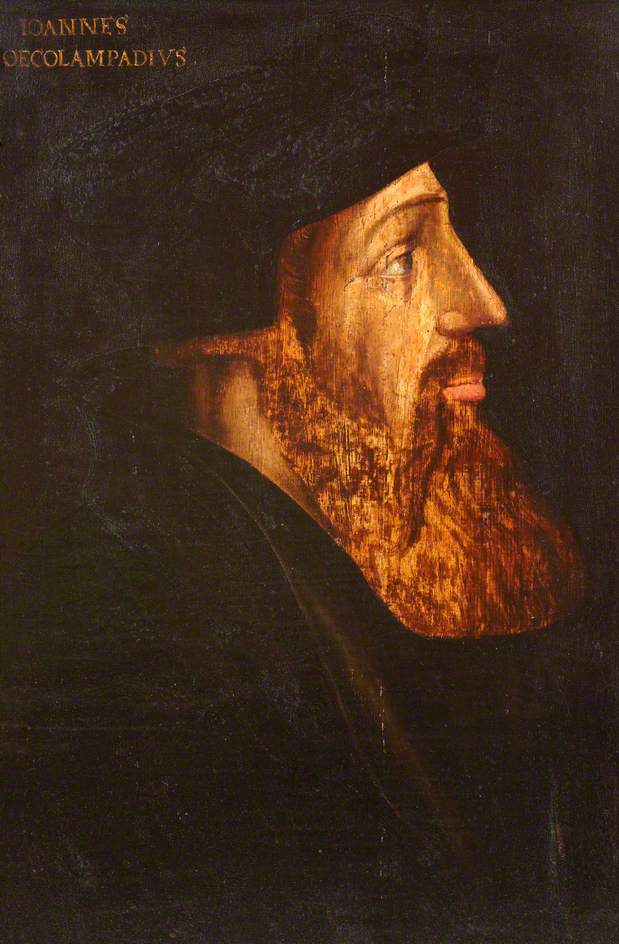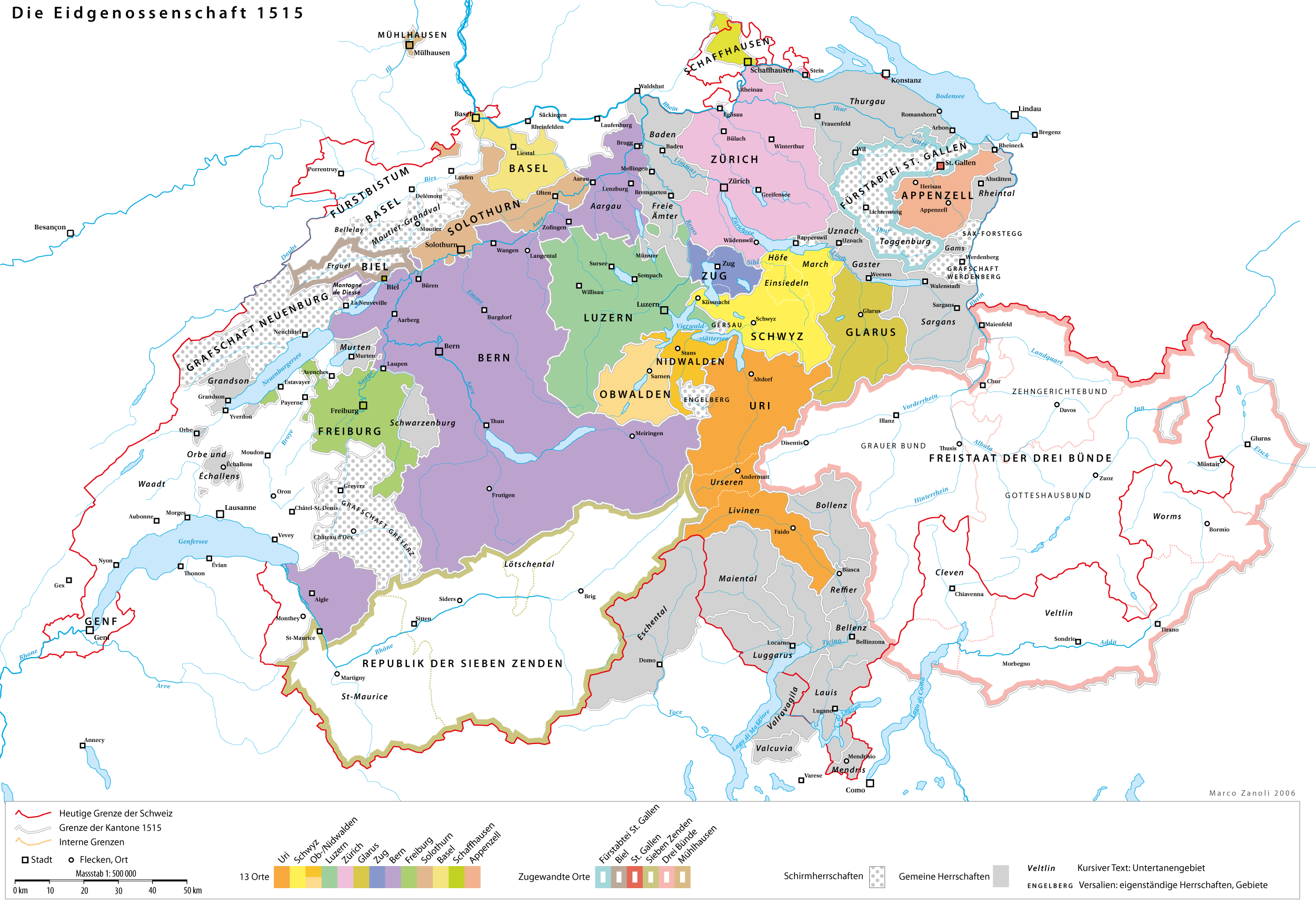|
Oecolampadius
Johannes Oecolampadius (also ''Œcolampadius'', in German also Oekolampadius, Oekolampad; 1482 – 24 November 1531) was a German Protestant reformer in the Calvinist tradition from the Electoral Palatinate. He was the leader of the Protestant faction in the Baden Disputation of 1526, and he was one of the founders of Protestant theology, engaging in disputes with Erasmus, Zwingli, Luther and Martin Bucer. Calvin adopted his view on the Eucharist dispute ( against Luther). His German surname was ''Hussgen'' (or ''Heussgen'', ''Huszgen''), which he etymologized to ''Hausschein'' ("house-shine") and graecized (as was the custom at the time) to Οἰκολαμπάδιος in all capital letters, without Greek diacritics, as may be seen in , quoting a verse of Johannes Rhellicanus. In modern times, his name has been published in lowercase using polytonic diacritics, viz. ( grc-gre, Οἰκολαμπάδιος) in ''katharevousa'' publications associated with the Greek Orthodox C ... [...More Info...] [...Related Items...] OR: [Wikipedia] [Google] [Baidu] |
Zwingli
Huldrych or Ulrich Zwingli (1 January 1484 – 11 October 1531) was a leader of the Reformation in Switzerland, born during a time of emerging Swiss patriotism and increasing criticism of the Swiss mercenary system. He attended the University of Vienna and the University of Basel, a scholarly center of Renaissance humanism. He continued his studies while he served as a pastor in Glarus and later in Einsiedeln, where he was influenced by the writings of Erasmus. In 1519, Zwingli became the Leutpriester (people's priest) of the Grossmünster in Zürich where he began to preach ideas on reform of the Catholic Church. In his first public controversy in 1522, he attacked the custom of fasting during Lent. In his publications, he noted corruption in the ecclesiastical hierarchy, promoted clerical marriage, and attacked the use of images in places of worship. Among his most notable contributions to the Reformation was his expository preaching, starting in 1519, through the Gosp ... [...More Info...] [...Related Items...] OR: [Wikipedia] [Google] [Baidu] |
Canton Of Basel
Basel was a canton of Switzerland that was in existence between 1501 and 1833, when it was split into the two half-cantons of Basel-City and Basel-Country. Background Before the Protestant Reformation, Basel was ruled by prince-bishops (see Bishop of Basel, whose memory is preserved in the crosier shown on the Basel coat of arms, as above). In the later 15th century, in the wake of the Council of Basel (1431–49), the city of Basel grew in wealth and importance. The University of Basel was established in 1459, and the city became an intellectual center of the German Renaissance in the years leading up to the Reformation. Erasmus of Rotterdam taught in Basel, and early printshops were set up by Johannes Petri and Johann Froben. In 1495, Basel was incorporated in the Upper Rhenish Imperial Circle, the bishop sitting on the Bench of the Ecclesiastical Princes. Establishment As a direct consequence of the Swabian War, resolved by the 1499 Treaty of Basel, Basel and ... [...More Info...] [...Related Items...] OR: [Wikipedia] [Google] [Baidu] |
Basel
, french: link=no, Bâlois(e), it, Basilese , neighboring_municipalities= Allschwil (BL), Hégenheim (FR-68), Binningen (BL), Birsfelden (BL), Bottmingen (BL), Huningue (FR-68), Münchenstein (BL), Muttenz (BL), Reinach (BL), Riehen (BS), Saint-Louis (FR-68), Weil am Rhein (DE-BW) , twintowns = Shanghai, Miami Beach , website = www.bs.ch Basel ( , ), also known as Basle ( ),french: Bâle ; it, Basilea ; rm, label= Sutsilvan, Basileia; other rm, Basilea . is a city in northwestern Switzerland on the river Rhine. Basel is Switzerland's third-most-populous city (after Zürich and Geneva) with about 175,000 inhabitants. The official language of Basel is (the Swiss variety of Standard) German, but the main spoken language is the local Basel German dialect. Basel is commonly considered to be the cultural capital of Switzerland and the city is famous for its many museums, including the Kunstmuseum, which is the first collection of art accessibl ... [...More Info...] [...Related Items...] OR: [Wikipedia] [Google] [Baidu] |
Erasmus
Desiderius Erasmus Roterodamus (; ; English: Erasmus of Rotterdam or Erasmus;''Erasmus'' was his baptismal name, given after St. Erasmus of Formiae. ''Desiderius'' was an adopted additional name, which he used from 1496. The ''Roterodamus'' was a scholarly name meaning "from Rotterdam", though the Latin genitive would be . 28 October 1466 – 12 July 1536) was a Dutch philosopher and Catholic theologian who is considered one of the greatest scholars of the northern Renaissance.Gleason, John B. "The Birth Dates of John Colet and Erasmus of Rotterdam: Fresh Documentary Evidence", Renaissance Quarterly, The University of Chicago Press on behalf of the Renaissance Society of America, Vol. 32, No. 1 (Spring, 1979), pp. 73–76www.jstor.org/ref> As a Catholic priest, he was an important figure in classical scholarship who wrote in a pure Latin style. Among humanists he was given the sobriquet "Prince of the Humanists", and has been called "the crowning glory of the Christian humanists ... [...More Info...] [...Related Items...] OR: [Wikipedia] [Google] [Baidu] |
Martin Bucer
Martin Bucer ( early German: ''Martin Butzer''; 11 November 1491 – 28 February 1551) was a German Protestant reformer based in Strasbourg who influenced Lutheran, Calvinist, and Anglican doctrines and practices. Bucer was originally a member of the Dominican Order, but after meeting and being influenced by Martin Luther in 1518 he arranged for his monastic vows to be annulled. He then began to work for the Reformation, with the support of Franz von Sickingen. Bucer's efforts to reform the church in Wissembourg resulted in his excommunication from the Catholic Church, and he was forced to flee to Strasbourg. There he joined a team of reformers which included Matthew Zell, Wolfgang Capito, and Caspar Hedio. He acted as a mediator between the two leading reformers, Martin Luther and Huldrych Zwingli, who differed on the doctrine of the Eucharist. Later, Bucer sought agreement on common articles of faith such as the Tetrapolitan Confession and the Wittenberg Concord, workin ... [...More Info...] [...Related Items...] OR: [Wikipedia] [Google] [Baidu] |
Calvinist
Calvinism (also called the Reformed Tradition, Reformed Protestantism, Reformed Christianity, or simply Reformed) is a major branch of Protestantism that follows the theological tradition and forms of Christian practice set down by John Calvin and other Reformation-era theologians. It emphasizes the sovereignty of God and the authority of the Bible. Calvinists broke from the Roman Catholic Church in the 16th century. Calvinists differ from Lutherans (another major branch of the Reformation) on the spiritual real presence of Christ in the Lord's Supper, theories of worship, the purpose and meaning of baptism, and the use of God's law for believers, among other points. The label ''Calvinism'' can be misleading, because the religious tradition it denotes has always been diverse, with a wide range of influences rather than a single founder; however, almost all of them drew heavily from the writings of Augustine of Hippo twelve hundred years prior to the Reformation. The ... [...More Info...] [...Related Items...] OR: [Wikipedia] [Google] [Baidu] |
Weinsberg
Weinsberg ( South Franconian: ''Weischberg'') is a town in the north of the state of Baden-Württemberg in Germany. It was founded around 1200 and is situated in the Heilbronn district. The town has about 11,800 inhabitants. It is noted for its wine. Geography Geographical position Weinsberg lies in the eastern Heilbronn district in the northeast part of Baden-Wuerttemberg, between the Neckar in the west and the Löwenstein mountains in the east. The small river Sulm rises from the Löwenstein mountains and flows into the Neckar after approximately . The valley formed of the Sulm and its tributaries is called ''Weinsberger Tal''. The city mainly lies in and on the tendencies of the valley of the Stadtseebach (also called Saubach), a southern tributary of the Sulm. The Sulm flows by Weinsberg's area, but not by the city itself, and only a small northern part of the city lies at the edge of the Sulm valley. Northwest of the town centre rises the Burgberg, with the ruins of '' Weibe ... [...More Info...] [...Related Items...] OR: [Wikipedia] [Google] [Baidu] |
Martin Luther
Martin Luther (; ; 10 November 1483 – 18 February 1546) was a German priest, theologian, author, hymnwriter, and professor, and Order of Saint Augustine, Augustinian friar. He is the seminal figure of the Reformation, Protestant Reformation and the namesake of Lutheranism. Luther was ordained to the Priesthood in the Catholic Church, priesthood in 1507. He came to reject several teachings and practices of the Catholic Church, Roman Catholic Church; in particular, he disputed the view on indulgences. Luther proposed an academic discussion of the practice and efficacy of indulgences in his ''Ninety-five Theses'' of 1517. His refusal to renounce all of his writings at the demand of Pope Leo X in 1520 and the Charles V, Holy Roman Emperor, Holy Roman Emperor Charles V at the Diet of Worms in 1521 resulted in his Excommunication (Catholic Church)#History, excommunication by the pope and condemnation as an Outlaw#In other countries, outlaw by the Holy Roman Emper ... [...More Info...] [...Related Items...] OR: [Wikipedia] [Google] [Baidu] |
Johannes Rhellicanus
Johannes Müller ( la, Johannes Rellicanus, also ''Rellikan'' or ''Rellikon'', ''circa'' 1478-1488 - 14 January 1542) was a Swiss clergyman and theologian of the Reformation in Switzerland, philologist and philosopher, noted for his work in early modern botany. Rhellicanus first came to prominence as an apt pupil, and then teacher, of Latin, Greek, and Hebrew. He studied at the Jagellonian University in Krakow (1517-22), and then at the University of Wittenberg (1522-5). In 1525, Rhellicanus became a teacher at St. George's Abbey, Stein am Rhein, near Zurich, where he taught Heinrich Bullinger during the latter's five-month stay in 1527 Zurich to study languages and attend the Prophezei; both were followers of Huldrych Zwingli. Rhellicanus was next appointed Professor of Greek and Philosophy at the new High School of Bern.On account of the Bern Debate of 1538, he returned to Zurich, where he was a teacher at the Latin school at Fraumünster. Later, in 1541 he became a p ... [...More Info...] [...Related Items...] OR: [Wikipedia] [Google] [Baidu] |
Calvinism
Calvinism (also called the Reformed Tradition, Reformed Protestantism, Reformed Christianity, or simply Reformed) is a major branch of Protestantism that follows the theological tradition and forms of Christian practice set down by John Calvin and other Reformation-era theologians. It emphasizes the sovereignty of God and the authority of the Bible. Calvinists broke from the Roman Catholic Church in the 16th century. Calvinists differ from Lutherans (another major branch of the Reformation) on the spiritual real presence of Christ in the Lord's Supper, theories of worship, the purpose and meaning of baptism, and the use of God's law for believers, among other points. The label ''Calvinism'' can be misleading, because the religious tradition it denotes has always been diverse, with a wide range of influences rather than a single founder; however, almost all of them drew heavily from the writings of Augustine of Hippo twelve hundred years prior to the Reformation. The na ... [...More Info...] [...Related Items...] OR: [Wikipedia] [Google] [Baidu] |
Greek Diacritic
Greek orthography has used a variety of diacritics starting in the Hellenistic period. The more complex polytonic orthography ( el, πολυτονικό σύστημα γραφής, translit=polytonikó sýstīma grafī́s), which includes five diacritics, notates Ancient Greek phonology. The simpler monotonic orthography ( el, μονοτονικό σύστημα γραφής, translit=monotonikó sýstīma grafīs), introduced in 1982, corresponds to Modern Greek phonology, and requires only two diacritics. Polytonic orthography () is the standard system for Ancient Greek and Medieval Greek. The acute accent (), the circumflex (), and the grave accent () indicate different kinds of pitch accent. The rough breathing () indicates the presence of the sound before a letter, while the smooth breathing () indicates the absence of . Since in Modern Greek the pitch accent has been replaced by a dynamic accent (stress), and was lost, most polytonic diacritics have no phonetic signi ... [...More Info...] [...Related Items...] OR: [Wikipedia] [Google] [Baidu] |




.jpg)
.jpg)



